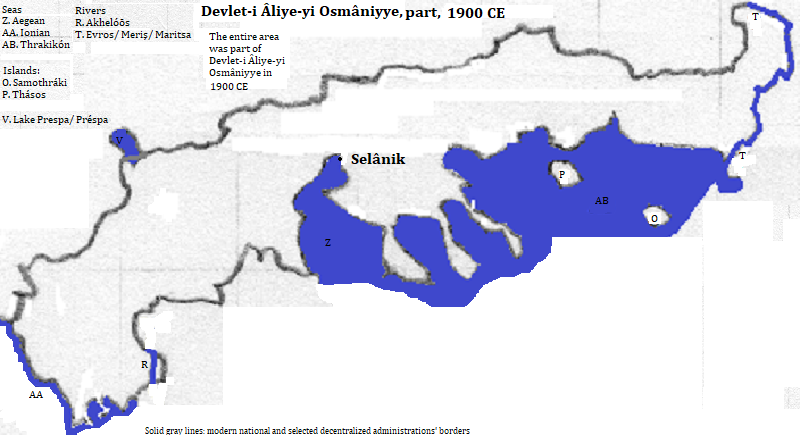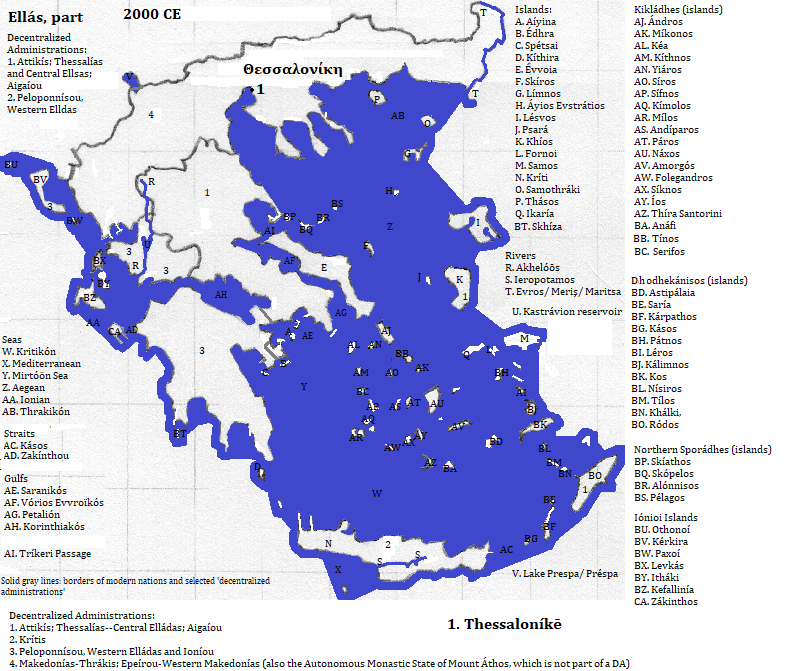
| To Duval Family Home Page | Europe |
| To Chris Home Page | Ελλάς (Ellás) |
| To Earth (Geography Home Page) |
Θεσσαλονίκη (Thessaloníkē),
Five early Christian churches, two of them with mosaic materpieces in their rotundas, are honored as a UNESCO World Heritage Site.
The nearby Θεσσαλονίκη (Thessaloníkē) International Airport is one of the nation's busiest.
| Name | Year | Population | Political entity |
| Θεσσαλονίκη (Thessaloníkē) | 622 CE | 40,000 | Rhomania or Romania (the Byzantine Empire) |
| Θεσσαλονίκη (Thessaloníkē) | 900 CE | 50,000 | Rhomania or Romania (the Byzantine Empire) |
| Θεσσαλονίκη (Thessaloníkē) | 1000 CE | 40,000 | Rhomania or Romania (the Byzantine Empire) |
| Θεσσαλονίκη (Thessaloníkē) | 1100 CE | 50,000 | Rhomania or Romania (the Byzantine Empire) |
| Θεσσαλονίκη (Thessaloníkē) | 1300 CE | 50,000 | Rhomania or Romania (the Byzantine Empire) |
| Selânik | 1400 CE | 40,000 | Devlet-i Âliye-yi Osmâniyye (Ottoman Empire) |
| Selânik | 1500 CE | 40,000 | Devlet-i Âliye-yi Osmâniyye (Ottoman Empire) |
| Selânik | 1600 CE | 50,000 | Devlet-i Âliye-yi Osmâniyye (Ottoman Empire) |
| Selânik | 1700 CE | 40,000 | Devlet-i Âliye-yi Osmâniyye (Ottoman Empire) |
| Selânik | 1800 CE | 62,000 | Devlet-i Âliye-yi Osmâniyye (Ottoman Empire) |
| Selânik | 1900 CE | 140,000 | Devlet-i Âliye-yi Osmâniyye (Ottoman Empire) |
| Θεσσαλονίκη (Thessaloníkē) | 2017 CE | 825,000 | Ελλάς (Ellás or Greece) |



Rotunda mosaic (Christian theme), Church of Saint David, Thessaloníkē, Makedonía, Ellás
1. Also transliterated as Thessaloníki; Thessalonica or Salonica in English.
2. Thermaic in English.
3. The Aegean is a northward extension of the eastern Mediterranean Sea, and through the Turkish Straits the connection between the Mediterranean and the Black seas.
4. Macedonia in English.
5. Also transliterated as Thráki. Thrace in English.
6. Also called Ελλάδα (Elláda); Greece in English.
7. Metropolitan estimate for 2017 from db-worldua, downloaded February 14, 2018 from http://www.demographia.com/.
8. 2011 figure from https://en.wikipedia.org/wiki/List_of_cities_in_Greece, accessed March 21, 2018.
9. Paul (or Saul) of Tarsus wrote two epistles to the Thessalonians that are part of the Christian Bible.
10. UNESCO, World Heritage Sites (Firefly Books, 2010).
11. Information about the buildings, other than the Christian churches, comes from emporis.com, accessed May 8, 2018. The rotary kiln of the Titan Industrial Cement Factory reaches 394 feet.
12. 2017 table from https://en.wikipedia.org/wiki/List_of_the_busiest_airports_in_Greece, accessed March 27, 2018.
13. Tertius Chandler, Four Thousand Years of Urban Growth, 2nd ed. (The Edwin Mellen Press, 1987), "Tables of the World's Largest Cities."
14. Chandler, op. cit.: 'Cities of Europe' tables.